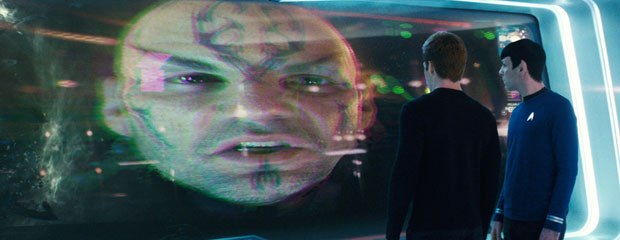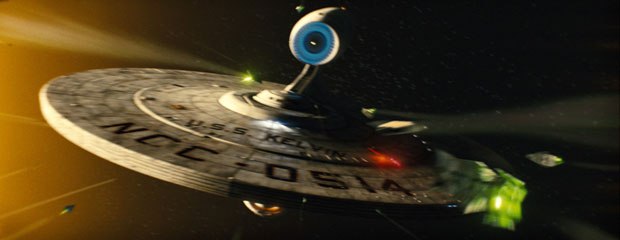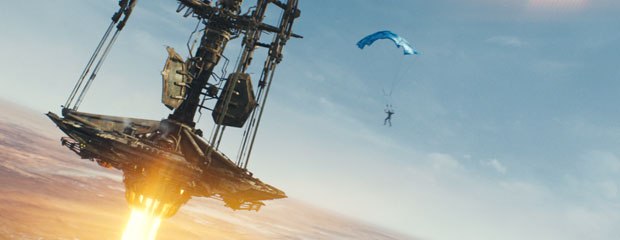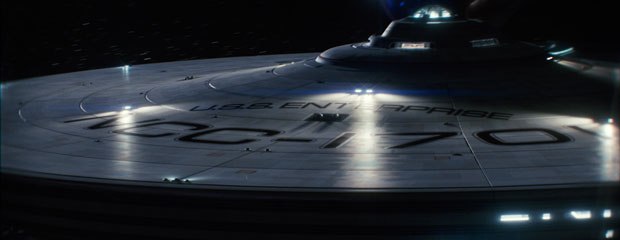Read how ILM was tasked with putting Star Trek on vfx steroids for J.J. Abrams' bold re-imagining.
J.J. Abrams admits that he's not a Trekkie -- the original Star Trek series and movies were never quite convincing enough for him as space adventures, and he never quite got the cultural vibe either. But, ultimately, he couldn't resist the opportunity to turn the franchise on its head with more action, zip and scope. In other words, he's put Star Trek on steroids to tell this origin story about how Kirk (Chris Pine), Spock (Zachary Quinto), McCoy (Karl Urban) and the rest of the beloved crew of the Enterprise meet and form the connective tissue of this Utopian phenomenon.
"What I thought was ingenious about our story was its own parallel universe," Abrams suggests. "It was all about treating it with believability… with reality… [And] it had to work at a higher resolution, not just because of IMAX but [also] because the audience is very sophisticated now and it had to work on a level they didn't have to worry about in '66."
Not surprisingly, Abrams chose Industrial Light & Magic to boldly go where no Star Trek had gone before. This included a whole new approach to space battles, explosions, black holes and planetary destruction, as well as cool upgrades for vfx involving the phaser, the transporter and Warp Speed. Along with it came some new wrinkles, including a new fracture program along with improved procedural rendering and volumetric shader tools. ILM handled 797 out of the 1,005 vfx shots (with additional support from Digital Domain, Lola, Svengali and others).
"We [definitely] wanted to take it in a new direction -- we wanted to make a harder kind of space movie," explains Roger Guyett, ILM's visual effects supervisor, who previously worked with the director on M:i:III. "And what I mean by harder is slightly more realistic and make it more about space exploration and making you feel more like you were going on this great adventure, and there's a certain amount of fear [involved] and really playing more with space, which would be lit more naturalistically. I looked at 2001, which I still think is incredibly well done. And I really enjoyed Sunshine for the way they tackled their version of space." (NASA's Carolyn Porco, who led the Imaging Science team on the Cassini mission at Saturn, assisted Guyett as a space consultant.)
One of the first things Guyett did was put together a Star Trek highlight reel of the previous films (which ILM worked on). "J.J. and I just talked about the kinds of moments we might have in our movie. And, of course, we were doing a prequel, so you have some kind of creative freedom. You can learn a lot about how they photographed the Enterprise in the older movies and learn what they'd done that was good and bad and do the best we can for our movie."
Abrams and Guyett got along so well, in fact, that the director entrusted him with the additional task of second unit director. "For me, it was a great experience," Guyett adds. "And often times you find visual effects supervisors working on the second unit because you're doing a lot of those action scenes that have visual effects in them. We did a lot of stuff related to the space jump and on the Delta Vega, the Ice Planet. I still remember spending a lot of time in editorial filling in holes. It puts you one step closer to the source of the movie so you're authoring material. You get inside the director's head a little bit more because you're talking about shot design and how the sequence is gonna work. And J.J. was trying very hard to photograph as much as he could, and that's not easy when you're doing a movie set in the future."
A harder space movie required some fundamental design updates to the Enterprise (particularly the Bridge). "It's a more muscular Enterprise," Guyett continues. "We didn't want it to feel too retro, but more contemporary to our time now in terms of the design lines and the way that the lines across the whole thing worked. It was a Scott Chambliss/Ryan Church design and then we took that silhouette and Alex Jaeger filled in all of the details. The idea of doing it in CG was out of necessity and more appropriate given the new shaders and other software tools that would provide more visual opportunities.
"The Bridge of the Enterprise is being compared to an Apple store. One thing that we tried to do is have the view screen opened up so you feel that connection between the people and where they and not have it seem like a closed set… a security camera view of the outside world. I love the idea of seeing the hood of the Enterprise, the dish spreading out before you when you sit in the captain's chair. We have a very particular approach to the design… we don't do impossible camera moves -- we wanted it to feel as though someone could've photographed it. Those are values that J.J. really stands for. He wants you to believe that you're really there."
Essentially, for the viewscreen, ILM tried to have a reference piece of glass for all of the reflections. It was a big piece of glass. In the end, it just turned into a greenscreen and they figured out a way of doing all the reflections in the glass itself. "It creates more and more work," Guyett says, "because every time you saw somebody in front of the screen, you, more often than not, had to put the Enterprise out there, or what you could see of it, and the whole world out there, so it increased the overall workflow, but was definitely worth doing."
For the transporter effect, the design was something that Abrams had very strong opinions about. "He wanted to take the essence of the idea: the light and the iconic sound, and make them more modern," Guyett offers. "The version you see in the movie is essentially his idea. The only way you can really tackle that is by literally matchmoving bodies as they are being transported. We'd have these stand-in figures and we'd match their motion and then generate particles that would circle all of their limbs and torso. It was actually one of those things that we thought would be easy to get down and we'd be off and running. But, in truth, every time someone is in a slightly different environment, you have to modify the effect. So it became so much more complicated. We spent a lot of time both designing and [doing it]. Each time there was some idiosyncrasy of the speed it was happening at and timing issues. It was harder to do than talking about it."
And Warp Speed had to be a more immersive experience as well, according to Guyett. "We wanted to be much more inside Warp and seeing the ship actually traveling in Warp, and outside looking in as well. It's this crazy abstraction. And I really like what we did creatively and visually. That was more my design of how I wanted it to look. What does it mean to travel faster than light?
Obviously in the early [shows] they were smearing a sort of slit scan effect. What's interesting is that there was a creative element to the notion of smearing through time. I wanted to take that one step further and that things within time can travel at different speeds, so that you have this strange feeling that you're going through ripple glass. Visually, there are so many good CG tools that you can use now. Essentially, it's a series of textures that we just warped. And just mapped these noise patterns onto cylinders and just smeared them through time. One of the compositing supervisors, Conny Fauser, came up with a way of blending these elements. You just get these elements and it becomes this mini art project. Warp was harder to talk about than to execute. All we had to do was generate some particles and then we had something to work with."
One of the biggest challenges was the black hole, which serves crucial narrative and visual functions. Fortunately, ILM was able to make use of an old friend from Pirates of the Caribbean. "I had done some research and there's an enormous amount of talent at ILM that knew about black holes and I compiled this hit list," Guyett offers. "You try to create something that seems plausible but then it becomes another art project as well. Alex Jaeger [visual effects art director] and I worked together on the concept. There was a similarity to the Maelstrom, and we developed some new tools that essentially take these particles and turn them into a whirlpool in space idea. Black holes are all about time itself: sucking and smearing the light into this black hole. We had two concepts: One was a time travel device and the other was: if you get it wrong, it will destroy you.
Thus, for the black hole, they did a new procedural rendering of particles and curves. "That gave it the look of open shutter lighting sort of thing," adds Joakim Arnesson, the effects CG supervisor. We used our new procedural rendering tool [developed by Dan Piponi]. This is much more flexible than RenderMan. This is more like a node-based tool. I can input my raw particles here, I can process them, I can jitter them and I can build and change color and parameters. Plus we can see it in GL in the viewer; we don't have to press render and let RenderMan render all of these points.
Guyett suggests that the whole concept of space, including the battles and explosions, was different from Star Wars in the sense that they paid much more attention to science and were better able to take advantage of the latest CG advances. "Simulations and automated processes and volumetric approaches are a lot easier," Guyett points out. "A couple of years in this business means you can do a virtual explosion now. We developed a virtual pyro technique, so we could fire on a space ship, it would hit and create a plausible explosion." Arnesson says that new volumetric shaders for smoke and plume effects were required for this. Software engineer Olivier Maury did base development and Raul Essig was the sequence lead for the explosions.
For tearing apart a planet, they wrote their own proprietary software, appropriately enough called Fracture. "We could take a sphere and, with the software, fracture it into a million pieces, and give them volume," Guyett explains. "This is achieved procedurally when the pieces break apart. Pieces collide with one another and fracture and create volumetric geometry on the fly. This was done by our Creature Dev department (under the leadership of Frank Petterson). While they were working on the physics of the simulation, we gave them a head start by animating the large pieces to provide appropriate weight and mass." Arnesson adds that they utilized such input data as size, scale of cell noise.
In a first for ILM, layout was rolled into animation for all CG shots. "We made a strong team of layout people, who were very keen on learning more about animation, and we took animators who had a very strong sense of composition and camera work," explains Paul Kavanagh, the animation director. "We would give a shot to one person who would perform all of these functions. We could turn work through the animation pipe very quickly and we could get a lot of through put and could also see high turnaround on the shot development at an early stage."
Because of various recuts (including the opening and the entire third act), ILM's animation was also called into previs action. POV worked for nearly a year on previs (including revisions of its own to eight scenes), before moving on to other projects. "[J.J.'s] very good at pinpointing the need for more mystery or emotional involvement or certain elaboration of story points within a given sequence," Kavanagh adds. "We took people that were strong in animation and turned them into a little previs department. We redefined the shots and got them clearer. Because we work with our assets, we can finesse it and send it through the pipeline. It all happened really fast and we all felt a certain sense of ownership and that we were making a movie together, which doesn't happen a lot."
There are two primary CG creatures that Kirk encounters on the Ice Planet, Delta Vega, including Big Red, which looks crab-like with a large snout, four legs and T-Rex-type arms. "Big Red's topology and design were so funky," Kavanagh admits. "He was so different. We wanted to make him feel like he was out of his element on the ice. He's a sea creature and only comes up to attack something. We had trouble animating that because of his snout. So we thought: What about reaching out with his tongue?"
Meanwhile, Digital Domain was brought in late to help out with 150 shots, including a CG Scottie being sucked through a water tube in the engineering bay, some hand phaser effects with Kirk and Spock aboard the Narada, set extension work during the opening Iowa sequence and a CG cop and motorcycle enhancement early on as well. (Digital Domain also contributed to a deleted Klingon prison scene.)
"The most technically challenging part was the engineering bay sequence, which was shot in a Budweiser plant that had a lot of set pieces -- orange pipe connectors, a big collection of cooling tubes full of inert reactant," explains Darren Poe, the digital effects supervisor. "So the tubes were going to be added later and it was shot anamorphically and stylistically there were a lot of lens flare and visual effects. So this is what we had to get behind, real estate to real estate, tracking through all that distortion and our CG stuff had to stack up against the real stuff, joining physically together, so it was pretty exacting."
Lola (supervised by Edson Williams) worked on 48 shots, including adding damage to the teeth of the villainous Romulan, Nero (played by Eric Bana). "We notched the teeth and added stains," Williams explains. "The damage was significant enough that we had to create clean plates of the inside of his mouth."
Lola additionally did some digital work on the mouth of the elder Spock (Leonard Nimoy) following a re-recording session. "We shot Leonard with high-def cameras and loosely matched the lighting to what was shot on set. The next step was to build teeth, tongue and lips, the lips were the only element that was 3D. We created a rig that linked up Leonard's digital teeth, tongue and lips and used rotomation to match the high-def footage from the ADR session. The shot could have been completed in 2D except the scene was lit by a fire pit and we needed the interactive lighting produced in Maya."
It's all part of the obsession with detail that is a hallmark of the franchise as well as Abrams' style of shooting.
Bill Desowitz is senior editor of AWN and VFXWorld.













